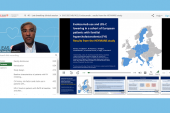Homozygous FH Diagnosis Often Comes Late, With Lackluster Care
A registry shows a wide discrepancy in care, with people from poor nations not receiving potent newer drugs.

Around the world, patients with homozygous familial hypercholesterolemia (HoFH) are diagnosed too late in life and remain significantly undertreated with LDL cholesterol-lowering medications, according to a new analysis of the HoFH International Clinical Collaborators (HICC) registry.
There is also a noticeable discrepancy in how patients are treated across the globe. HoFH patients from high-income countries are much more likely to be treated with multiple medications, including some of the newer agents like PCSK9 inhibitors and the monoclonal antibody evinacumab (Evkeeza; Regeneron), and to achieve guideline-recommended LDL cholesterol targets than those from lower-income countries.
“It’s really difficult to get the LDL-cholesterol levels of these patients under control,” lead investigator Tycho R. Tromp, MD (Academic Medical Center, Amsterdam, the Netherlands), told TCTMD. “And really, there is a large inequity in how these patients are being treated. We frequently communicate with [HICC] collaborators from all over the world, with many of those working in non-high-income countries, and they’ll tell us they only have statins available. That just doesn’t do the job because these patients are just so much more severely affected [by high LDL-cholesterol levels].”
Published recently in the Lancet, the HICC registry report includes data on 751 patients with HoFH from 38 countries. The condition is a rare genetic dyslipidemia that affects roughly one in every 300,000 people worldwide. Depending on the genetic variants, plasma LDL-cholesterol levels can be stratospherically high, more than 20 mmol/L (roughly 775 mg/dL). Given these high LDL-cholesterol levels, statins alone are just not enough, say investigators, nor are statins and ezetimibe in combination.
Frederick Raal, MBBCh, PhD (University of the Witwatersrand, Johannesburg, South Africa), a member of the HICC registry steering committee, said that the high LDL levels result in premature, accelerated atherosclerotic cardiovascular disease (ASCVD), particularly coronary artery disease, which often manifests in childhood.
“Because of severity of homozygous FH, early diagnosis and early initiation of treatment is paramount,” said Raal during a video commentary posted on the European Atherosclerosis Society website. “However, because of the markedly elevated LDL-cholesterol levels, multiple lipid-lowering drug therapies, often in combination with LDL apheresis, is required.”
In an editorial, Rosa Sánchez-Hernández, MD (Universidad de Las Palmas de Gran Canaria, Spain), and Fernando Civeira, MD (Universidad de Zaragoza, Spain), note that the primary diagnosis of HoFH, especially in low-income countries, tends to be clinical. A genetic diagnosis, which mainly occurs in affluent countries, is also complex since it requires the analysis of four genes (LDLR, APOB, PCSK9, and LDLRAP1) with multiple allelic combinations.
“This diagnostic process requires specialized units that are not always available to patients,” they write. As a result, when diagnosis does occur, many patients have already developed serious complications, even in their first decade of life.
Barriers to Accessing Treatment
In the HICC registry, the median age at the time of HoFH diagnosis was 12.0 years. At diagnosis, ASCVD or aortic stenosis was already present in roughly one in ten patients. Prior to treatment, the overall mean LDL-cholesterol level was 14.7 mmol/L (568.4 mg/dL), although it was slightly higher in lower-income countries (15.8 mmol/L, or 610 mg/dL) than in high-income countries (13.5 mmol/L, or 522 mg/dL).
For the 534 patients with complete treatment information, 92% of patients were treated with statins, 64% with ezetimibe, 22.1% with a PCSK9 inhibitor, 8.4% with lomitapide (Juxtapid/Lojuxta; Aegerion Pharmaceuticals), and 2.4% with evinacumab, an inhibitor of ANGPTL3. Additionally, 39% were treated with LDL apheresis. Compared with high-income countries, more patients from lower-income settings received statins but those from poorer nations were less likely to receive additional agents, including ezetimibe (53.9% vs 72.4%), PCSK9 inhibitors (17.4% vs 25.9%), lomitapide (2.1% vs 13.7%), and evinacumab (0 vs 4.4%).
“Treatment inequity was found to be a major issue,” said Raal. In addition to receiving the newer lipid-lowering therapies less frequently than those in high-income countries, access to LDL apheresis was also delayed for HoFH patients in lower-income countries, he added.
Investigators are currently following up with HICC partners from non-high-income countries to better understand barriers to treatment. Cost is an obvious one. Evinacumab, an orphan drug approved in 2021 by the US Food and Drug Administration for HoFH, is currently priced (whole acquisition cost) at $450,000 US per year. Lomitapide also costs roughly $300,000 US per year.
“For some countries, it’s going to be cost,” said Tromp. “For a lot of other countries, it’s simply because the drug is not available in that country because the pharmaceutical company might not see a market there and so it doesn’t pass through legislation [and get approved]. Or it might simply be the way that drugs are reimbursed. In some countries, the government offers lipoprotein apheresis, which is costly and invasive, but if patients want to get other medications, there are out-of-pocket costs to access. I think [barriers] can be the result of the way reimbursement is set up.”
Overall, the on-treatment LDL-cholesterol levels were 7.7 mmol/L (297.8 mg/dL), but concentrations remained much higher in patients treated from lower-income countries (10.1 mmol/L, or 390.6 mg/dL) than those from high-income countries (4.9 mmol/L, or 189.5 mg/dL). The percentage of patients who achieved guideline-recommended LDL targets—less than 2.6 and 1.8 mmol/L (less than 100 and 70 mg/dL) for primary and secondary prevention, respectively—was low. For example, just 10.9% of patients had their LDL cholesterol reduced below the guideline-recommended targets, including 21% of patients from high-income countries and 3% from lower-income countries.
“One thing that is hopeful is that we saw that if you just give patients more and more lipid-lowering therapies—for example, if you give patients five different classes of therapy—it is possible to get these patients to LDL-cholesterol goals,” said Tromp. “Hopefully we can do much better in the future for these patients.”
Global Policy and Drug Access
Despite the optimism, Tromp noted that HoFH patients had limited options for treatment for a very long time and many have already experienced MI or required CABG surgery, PCI, or aortic valve replacement.
Overall, the MACE rate was 28.8%, with rates relatively similar between those from high- and lower-income countries (27.2% vs 29.9%, respectively). The risk of cardiovascular death was twofold higher for patients in less-affluent countries and these patients died at much younger ages. Investigators also observed a significant difference in the age of patients at the time of MACE, with more than a 10-year difference between those from high- and lower-income countries (median 37.0 vs 24.5 years). The average age at the time of MACE in the entire HoFH cohort was 31.0 years.
Tromp said the HICC registry will allow researchers, physicians, and public health advocates to show government, payers, and the pharmaceutical industry that there is “so much to be gained” from diagnosing and treating patients with HoFH. “I would be really happy if this led to more access with compassionate use [through] some of the early-access programs for the new lipid-lowering therapies,” he said. “And not just within the high-income countries.”
Raal made similar comments, saying that they hope these new data can be leveraged toward global health policies that ensure better access to lipid-lowering therapies, particularly for patients living in less-affluent countries.
Michael O’Riordan is the Managing Editor for TCTMD. He completed his undergraduate degrees at Queen’s University in Kingston, ON, and…
Read Full BioSources
Tromp TR, Hartgers ML, Hovingh GK, et al. Worldwide experience of homozygous familial hypercholesterolaemia: retrospective cohort study. Lancet. 2022;Epub ahead of print.
Sánchez-Hernández RM, Civeira F. Homozygous familial hypercholesterolemia: still a long way to go. Lancet. 2022;Epub ahead of print.
Disclosures
- Tromp reports no relevant conflicts of interest.
- Raal reports consulting fees, lecturing fees, and advisory board fees from Amgen, Sanofi-Aventis, Regeneron, Novartis, and Lib Therapeutics.
- Civeira reports receiving fees from Merck and serving on advisory boards for Amgen and Sanofi.





Comments